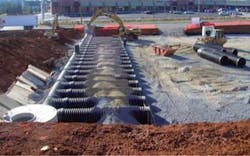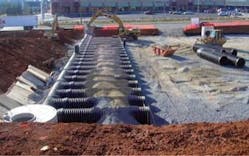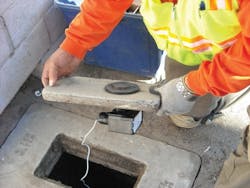Roy Fallon, chief operator of the wastewater treatment plant at the Village of Tequesta in Palm Beach County, Fla., said that after the company installed two reverse osmosis systems back in 2000, it was more than eight years before the membranes needed to be cleaned. Naturally, after using a reverse osmosis system for eight years to desalinate a water supply - and never cleaning it even once - one might assume that the build-up of dirt and slime would be more than even a hazmat team could stomach.
But that's not the case at the Village of Tequesta.
"We've recently passed eight years since we installed the reverse osmosis systems, and we haven't had to clean them once," said Fallon, who is responsible for managing all phases of water treatment at the plant, including maintenance, water quality control, and laboratory safety. "From my experience, even with a relatively clean water source, when you hit six or seven years with one of these systems, you've typically gone through multiple cleanings and you're even thinking about replacing the membranes."
"Yet it was eight years before we reached the point when the membranes, supplied by Koch Membrane Systems (KMS), underwent their first cleaning. It was pretty remarkable."
Located at the very northern end of Palm Beach County, the water treatment plant in the Village of Tequesta serves 5,000 water customers, including residents of Tequesta, Jupiter Village, and Jupiter Island, as well as a number of residents from unincorporated areas of Palm Beach and Martin Counties. Based on the superior performance of the RO systems, which have increased the capacity of the plant to more than 5 million gallons per day (mgd) of potable water, Tequesta now enjoys complete water supply autonomy.
Village of Tequesta Challenges: How It All Began
In the early 1980s, the local water management district discovered a significant amount of salt water intrusion occurring in the surficial aquifer from which the Tequesta water treatment plant was extracting its water supply. This salt water intrusion subsequently entered the village's wells.
Due to the unwanted movement of the salt water/freshwater interface, and in order to prevent more intrusion, the water management district implemented restrictions on the amount of water the plant could extract from the upper aquifer. Consequently, Tequesta officials developed a plan to draw water from a much deeper aquifer (the wells are down 2,000 feet; in the upper aquifer they descend a mere 100 feet). Because there were no restrictions on the deeper water supply - a supply that was far more abundant - the amount of water the plant needed to take from the upper aquifer was greatly reduced, alleviating the salt-water intrusion dilemma.
Unfortunately, this seemingly perfect solution had a downside: the water in the deeper aquifer was far more brackish, with a much higher salt content. This meant that while the aquifer itself would not be subject to salt water intrusion, it would clearly require desalination before it was suitable for consumer use. Water from the upper aquifer had been treated using a standard aeration filtration system to remove iron and was then subsequently chlorinated. However, since the water from the upper aquifer was much purer, it did not require the level of treatment that deeper water would. Thus, the existing system had not been designed to provide the desalination that the deeper aquifer demanded.
Koch Membrane Systems Helps Solve Problem
Eager to identify a suitable solution, Tequesta officials solicited bids from a variety of engineering firms. The winning bid was ultimately submitted by Arcadis Engineering and the firm was contracted to design a new plant and recommend all of the requisite equipment.
"We were certainly aware of the kinds of processes available for a project of this type, such as electrodialysis reversal and ion exchange," said William D. Reese, now vice president of Arcadis, a multi-disciplinary, international engineering firm headquartered in Denver. "But we didn't try to go against the grain in terms of where the industry was headed. We were confident that a membrane-type process, specifically reverse osmosis, would be the optimal approach."
The facility was built to house a maximum of three 1.2 mgd RO trains, for a total capacity of 3.6 mgd. Currently there are two installed trains; the second one was commissioned in 2007. Both trains use the KMS MAGNUM® 8060-HR-575 elements. After the water is pumped from the newer, deeper water source, booster pumps increase the pressure to provide the proper operating pressure for pre-treatment with sulphuric acid to keep the pH low; the lower pH helps keep the hydrogen sulfide gas in the well water throughout the process. An anti-scalant is then added to prevent the formation of carbonates, after which the water travels through a pre-filter (one micron), before going to the high pressure pump which increases the pressure to the RO membranes.
Once at high pressure, about 276 pounds per square inch (psi), the water is forced through the semi-permeable membranes to separate the impurities; the filtered water or permeate passes through the membrane and the concentrate is sent to waste and discharged. The permeate from the RO is pumped to the clearwell, or finished water tank, where it's mixed with the 2.74 mgd of water still being drawn from the upper aquifer and going through a filtered system; the entire mix is then treated via the older filtration process, then goes into a clear well.
The entire water treatment system is fully treated with chlorine and computer-driven; any out-of-range conditions are immediately communicated to plant operators for remediation or shutdown. This RO permeate is a very high-quality water, more like a distilled water, which makes it an excellent complement to the older water source.
"Combining the two water sources produces a perfect blend," says Reese. "The older source comes out with a couple hundred parts per million of calcium hardness, which helps improve the taste. By blending it with the newer source, we still have enough calcium for taste concerns but overall it's a purer end product. And with over 5.1 mgd of total capacity, we're more than satisfying the needs of our customers, even in times of peak demand."
More WaterWorld Current Issue Articles
More WaterWorld Archives Issue Articles





